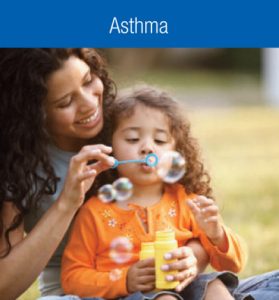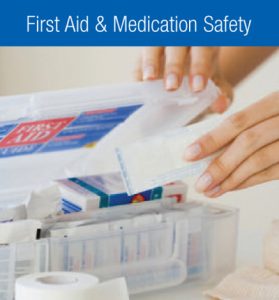As easy as breathing. It sounds like such a simple thing, but if you have asthma, breathing is not simple at all. Asthma is a chronic lung condition in which the airways are extra sensitive, which causes them to react by narrowing, making breathing difficult.

Asthma can occur in people of any age, but it usually strikes for the first time during childhood. At least 12% of Canadian children and 8.4% of the population age 12 and over have been diagnosed with the condition. Asthma is the leading cause of absenteeism from school and the third leading cause of work loss.
The first signs are often a cough or slight shortness of breath, especially after exercise. Other common signs are wheezing, coughing, and chest tightness. One in three children has at least one episode of wheezing by the third birthday and close to half will have an episode by the sixth birthday. About half of preschool children with wheezing will outgrow the problem. The symptoms can be similar to the symptoms of allergic reactions, bronchitis, or postnasal drip, so your doctor may want to perform some tests to rule out other breathing problems and to make sure that your problem is asthma before beginning treatment.
Once your doctor is sure that your problem is asthma, you can plan to control the symptoms. The first step is to develop an action plan, a series of instructions that your doctor will customize for you. Your action plan should be in writing, and you should make sure you understand it completely. It will include instructions on when you should contact the doctor, under what circumstances you should adjust your medication, when you should go to the hospital, and what you should do on the way.
Asthma Medicines
Medication will play a large part in helping you manage your asthma. There are two main types of medication you will become familiar with: anti-inflammatory drugs (also known as preventers) and bronchodilators (also known as relievers or rescue drugs).
Anti-inflammatory medications help to prevent attacks by reducing inflammation, swelling, and mucus in the airways. This prevents symptoms such as coughing, wheezing, and breathlessness. In order for these medications to work, you must take them on a regular basis. Preventer medicines act slowly and will not stop an asthma attack.
Bronchodilators relieve the spasms in the muscles surrounding the airways that bring on sudden symptoms. They are taken once an asthma attack has started, and they work by relaxing the tight muscles that narrow the breathing passages. With the muscles more relaxed, air can move more easily through the airways. Because the regular, frequent use of bronchodilator therapy may actually worsen asthma, one of the goals of treatment is to prevent symptoms, reducing the need for these drugs.
It is crucial that you use your inhaler properly, or you won’t get the maximum benefit from it. If you have any questions about using your inhaler, your London Drugs pharmacist can help.
Your Asthma Diary
Taking your medication is important, but it is not the whole story. The medicines help you control your asthma symptoms, but they cannot cure the condition. Fortunately, there are a number of other steps you can take to help manage your asthma so you can lead a full, active life. One important component of an asthma management program is to keep an asthma diary. This is really very easy to do, and it will help you pinpoint the factors that trigger your asthma attacks as well as help you chart the progress of your treatment.
To maintain an asthma diary, you will need to measure your breathing with a peak flow meter. Record this measurement in your asthma diary along with the date and time of the reading. It can also be helpful to record how you feel at the time of the test (for example, “no difficulty breathing” or “chest feels tight”) and to record what you ate and what activities you participated in around the time of the reading (for example, “rode bicycle for half an hour then ate a chocolate bar”). Keeping track of your symptoms and what you ate and what you were doing when they occurred will help you identify those things that trigger your body to have an asthma attack.
It will also help you keep track of how well your medication is working so you and your doctor can decide whether your treatment plan needs to be modified.
Identifying Your Triggers
Many things can trigger an asthma attack, and they vary from person to person. Asthma triggers fall into two main categories: allergic triggers and non-allergic triggers. Allergic triggers include pollen, mould, animal dander, dust mites, and some foods. Non-allergic triggers include smoke, fumes, perfumes, weather conditions, intense emotions, infections, exercise, and some medications. If you aren’t sure whether any of the medicines you take could trigger asthma symptoms, talk with your London Drugs pharmacist.
It would be wonderful if you could identify all of your triggers and avoid them, but that isn’t usually possible. It would be difficult to avoid all pollen or smoke, and it would be next to impossible to avoid all emotional situations or weather conditions. However, if you know what your triggers are, you can do a lot to reduce your exposure to them. For example, if grass pollen triggers your asthma, you can stay indoors when the grass is being cut; if perfume is one of your triggers, you can look for unscented products and avoid perfumes and colognes; if cold air causes you problems, you can try skating in an indoor rink.
Another important factor in controlling asthma is to remain physically fit, because exercise helps to improve the respiratory system. However, people with asthma have to be careful to prepare properly before beginning an activity. This may mean adjusting the medication, so it is important to discuss your plans with your doctor before beginning an exercise program or participating in a sport.
Sometimes You Need a Change
As long as you can maintain good control of your asthma symptoms, you and your doctor will probably continue with the action plan you developed at the start of your treatment program. However, sometimes the plan needs to be adjusted as the treatment progresses. There are signs you should watch for that will indicate that a treatment change might be necessary.
Be alert to the following and tell your doctor if:
- your symptoms begin to interfere with your daily activities
- your reliever medicine doesn’t provide complete relief or if you have to increase the amount you use to get relief
- your peak flow readings drop
- you begin to have difficulty exercising
- you experience shortness of breath when you haven’t been exercising
- you have persistent tightness in your chest or morning wheezing
- you awaken more than two nights in a row coughing or wheezing.
Sometimes your asthma may require immediate medical attention. Call your doctor or visit the emergency room immediately if:
- you have a severe asthma attack
- you get chest pains
- you begin to cough and cannot stop
- your oral temperature rises above 38º C (100º F) during an asthma attack.
Your Pharmacist
There are many ways your London Drugs pharmacist can help you manage your
asthma, such as:
- explaining how and when to take your medication
- demonstrating how to use inhaler devices and peak flow meters
- clarifying your doctor’s instructions
- advising on over-the-counter medicines that are appropriate for people with asthma.
If you have any questions about your condition or the medicines you take, remember that your pharmacists are here to help you.
Above all, there is one thing to remember about asthma: You can control it. If you follow your treatment plan, take your medicine properly, identify your triggers and minimize your exposure to them, and stay physically fit, you can lead a full and active life.







